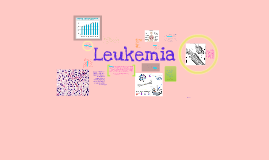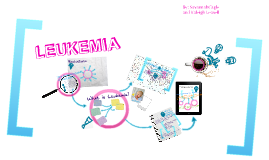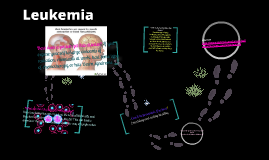Leukemia
Transcript: Leukemia Drums Girls and Dangerous Pie By: Charity Davis Story Written By: Jordan Sonnenblick Incidence of Leukemia In the United States, about 2,000 children and 27,000 adults are diagnosed each year with leukemia. The most common types of leukemia in adults are AML and CLL. ALL is very rare in adults, and is the most common form of leukemia in children. The incidence of leukemia is more common in men and boys than girls and women, and also more likely to occur in white people than black. Although people of any age can get leukemia, it is most common in adults over 60 years of age. What are the Risk Factors for Leukemia? For most types of leukemia, the risk factors and possible causes are not known. Some possible risk factors for leukemia include: • Previous cancer treatment: Certain types of chemotherapy and radiation therapy for other cancers. • Exposure to high levels of radiation: Exposure to high-energy radiation (e.g., atomic bomb explosions) and intense exposure to low-energy radiation from electromagnetic fields (e.g., power lines). • Chemical exposure: Long-term exposure to certain pesticides or industrial chemicals, like benzene. • Genetic diseases: Certain genetic abnormalities, such as Down syndrome, may play a role in the development of leukemia. • Gender: Men are more likely to develop CML, CLL and AML than women. • Age: The risk of most leukemias, with the exception of ALL, typically increases with age. • Smoking: Smoking cigarettes increases the risk of developing AML. • Family history: Most leukemias have no family link. However, first degree relatives of CLL patients, or having an identical twin who has or had AML or ALL, may put you at an increased risk for developing the disease. General Leukemia Symptoms: •Fever, chills •Fatigue, weakness •Loss of appetite, weight loss •Night sweats •Bone / joint pain •Abdominal discomfort •Headaches •Shortness of breath •Frequent infections •Easy bruising or bleeding •Petechiae (small red spots under the skin) Classifications Type A- Acute leukemia- In acute leukemia, the abnormal blood cells are immature blood cells (blasts). They can't carry out their normal work, and they multiply rapidly, so the disease worsens quickly. Acute leukemia requires aggressive, timely treatment. Chronic leukemia.-This type of leukemia involves more mature blood cells. These blood cells replicate or accumulate more slowly and can function normally for a period of time. Some forms of chronic leukemia initially produce no symptoms and can go unnoticed or undiagnosed for years. Type B- Lymphocytic leukemia- This type of leukemia affects the lymphoid cells or lymphocytes, which form lymphoid or lymphatic tissue. Lymphatic tissue makes up your immune system. Myelogenous (MI-uh-loj-uh-nus) leukemia. This type of leukemia affects the myeloid cells. Myeloid cells give rise to red blood cells, white blood cells and platelet-producing cells. The major types of leukemia are: Acute lymphocytic leukemia (ALL), which is most common in children, Acute myelogenous leukemia (AML), which occurs in both children and adults, Chronic lymphocytic leukemia (CLL), the most commonly adults leukemia and very rare in children,and Chronic myelogenous leukemia (CML), which mainly affects adults. My topic relates to this novel because Jeffrey has acute leukemia. It also adds an extra understanding for what these terms mean and why they are urgently rushing procedures. This topic showed me that there are things that we pass by everyday and dont understand that it can really affect us. Sources: -MayoClinic.com -http://kidshealth.org/parent/medical/cancer/cancer_leukemia.html -http://www.cancercenter.com/causes-of-leukemia.htm Leukemia Leukemia — Comprehensive overview covers symptoms, causes, risk factors, treatment of this blood-related cancer. Definition Leukemia is cancer of the body's blood-forming tissues, including the bone marrow and the lymphatic system. Many types of leukemia exist. Some forms of leukemia are most common in children. Other forms of leukemia occur mostly in adults. Leukemia usually starts in the white blood cells. Your white blood cells are potent infection fighters — they normally grow and divide in an orderly way, as your body needs them. But in people with leukemia, the bone marrow produces a large number of abnormal white blood cells, which don't function properly. Treatment for leukemia can be complex — depending on the type of leukemia and other factors. But there are strategies and resources that can help to make your treatment successful. Symptoms Click to enlarge Petechiae may look like a rash and usually appear in clusters. Here they appear on a leg (A) and on an abdomen (B). PetechiaeLeukemia symptoms vary, depending on the type of leukemia. Common leukemia signs and symptoms include: Fever or chills Persistent fatigue, weakness Frequent infections Losing weight without trying Swollen lymph nodes, enlarged liver or spleen Easy bleeding or bruising Tiny red spots in

















